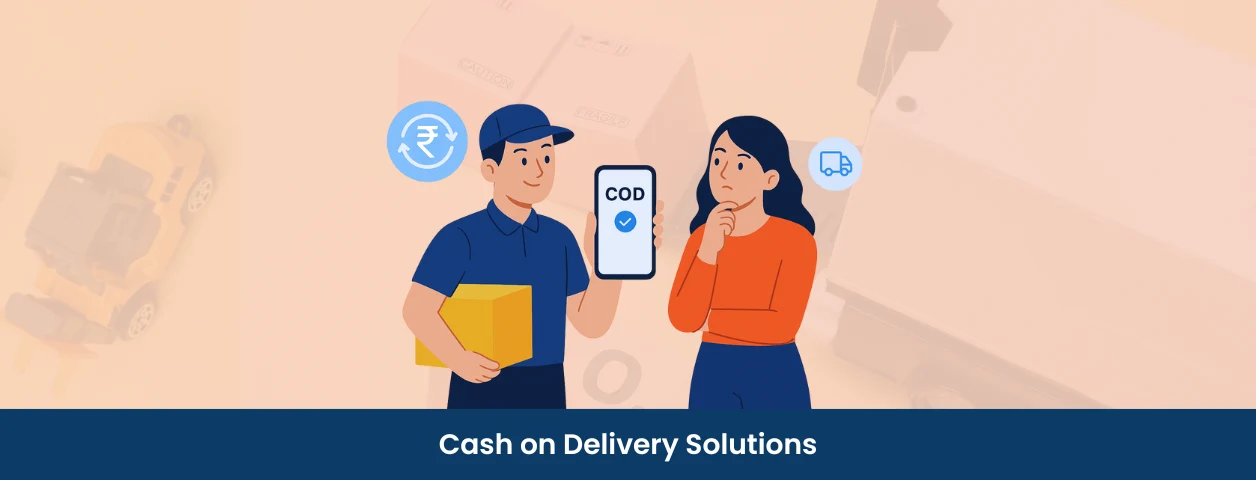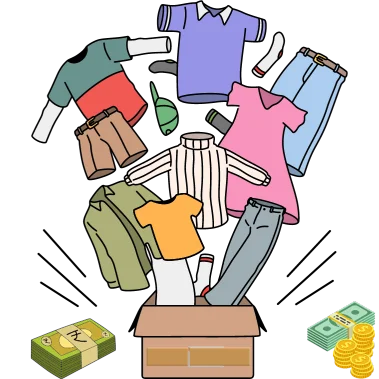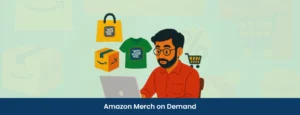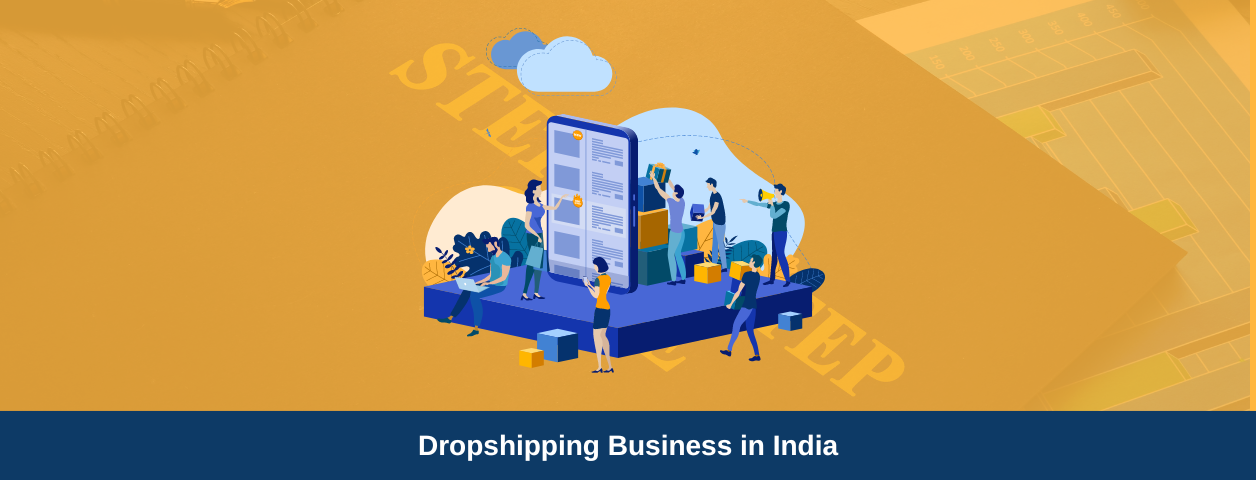Cash on Delivery problems continue to be one of the biggest challenges for eCommerce businesses in India. While COD (Cash on Delivery) has helped millions of shoppers trust online buying, it also brings the highest share of order cancellations and Return to Origin (RTO) losses for sellers.
In India, shoppers choose cash on delivery for trust and convenience. However, for online brands, it comes with extra shipping costs, higher returns and slower cash flow. That’s why understanding how Cash on Delivery works, what causes COD losses, and what the solutions are to handle the COD reduction is crucial.
If you’re running an online store business, this guide will help you turn a cash on delivery order from a risky expense into a more controlled, profitable payment option.
Key Takeaways:
- Cash on Delivery (COD) remains a major driver of eCommerce orders in India, especially for new buyers.
- COD problems mainly arise due to trust issues, fraudulent orders, returns and delayed fulfilment.
- Dropshippers must manage cash on delivery carefully due to higher Return to Origin (RTO) risks and tighter margins.
- A balanced approach between offering COD and optimising prepaid can enhance Return on Investment (ROI).
What is Cash on Delivery & How it Works?

Cash on Delivery or COD is a method of payment where customers pay for their order only when the product reaches their doorstep. Instead of paying upfront during checkout, the buyer pays the courier partner directly once the item is delivered, either in cash or through card and UPI at the point of delivery.
This system builds trust among customers who still hesitate to share card details online or are doubtful about product quality before seeing it. For people who are new to online shopping, COD serves as a safer option that encourages them to place their first order confidently. This trust factor is the main reason COD became the backbone of India’s eCommerce growth.
Cash on delivery also produces problems, including delayed cash settlements, fake orders, and high chances of Return to Origin (RTO) rates, where customers decline to accept the delivery. Every such case incurs additional costs and reduces the seller’s profit margins.
Let’s now discuss how cash on delivery works:
- The customer places an online order, choosing the COD cash on delivery option in the store.
- The store processes the order, packs it and dispatches the order through a courier that supports cash collection for orders.
- During the delivery, the courier partner delivers the product and collects payment, and later confirms it to the seller. The payment collected is transferred to the seller after a settlement cycle.
- If the buyer did not accept the delivery, it returns to the seller’s address and is marked as an RTO.
Although many stores accept this model, managing those COD orders is now more important than ever. With the cash on delivery app Shopify, sellers can still offer some money on delivery services while managing their profit margins.
Why Cash on Delivery is Important in India?

While most shoppers across the world rely on online prepaid payments, India remains a unique market where cash on delivery plays a major role in the growth of eCommerce. Not only with first-time shoppers, but even regular shoppers have trust issues and prefer only the cash-on-delivery payment option.
A new eCommerce business or a dropshipping store coming into the industry with the COD mode of payment available can attract new buyers and will effectively increase its profit. The COD is now running the eCommerce industry in every rural and urban area, giving accessibility for online shopping to almost everyone.
Despite the growth of UPI and other payment gateways, cash on delivery contributes a significant share to the development of these online product-selling businesses. So this remains as one of the most considerable supports for the new or upcoming entrepreneurs in this industry.
If any brand removes the cash on delivery option, their order abandonment rate increases. By handling COD orders efficiently, eCommerce brands can perfect the balance between customer trust and profitability.
Why Cash on Delivery Shipping Dominates Indian eCommerce?
Cash on delivery proves to be the most important feature of the Indian eCommerce industry, where it attracts new purchasers to the online store. For the convenience of the sellers, the courier partners have improved COD shipping services by integrating card swipes, UPI scanning, and secure cash handling.
These things have made the cash on delivery logistics easier and more reliable for the customers. COD remains this strong because of a few primary factors:
- Customers feel secure knowing they only pay when the product is physically in hand. This reduces hesitation and increases purchase confidence, especially for first-time buyers.
- Not everyone has a UPI or card, especially people in rural areas. So this COD payment introduces a new generation to the industry.
- Buyers want to avoid situations where money gets deducted, but the order fails and the refund takes time.
- Indian buyers are accustomed to offline retail shops. Only with COD orders, their online shopping entry barrier could be broken, with which new brands can also convert their ads into purchases.
In short, Cash on Delivery works the same as traditional offline shopping does, handing over the product before payment. For Indian eCommerce, it remains not just a payment option, but a trust-building bridge that supports for a long-term brand growth.
Cash on Delivery vs Prepaid Orders
|
Factor
|
Cash on Delivery (COD)
|
Prepaid
|
|---|---|---|
|
Customer Trust
|
High for first-time buyers
|
Medium: buyers expect trust
|
|
Order Volume
|
Higher
|
Slightly Lower
|
|
Return to Origin (RTO)
|
Customers can return a delivery at any time
|
Reduces the chances of cancellations
|
|
Shipping and Handling Cost
|
Reattempt costs and additional charges can be high
|
No handling cost, only considerable shipping costs
|
|
Cash Flow and Settlement
|
Slower cash cycle from the courier partner to the seller
|
Instant payment to the seller directly
|
|
Fake Orders
|
Chances are high
|
Chances are typically low
|
|
Customer Experience
|
Convenient for first-time and cash-reliant customers
|
Provides a faster and smoother delivery experience
|
|
Profit Margin
|
Logistics costs add up, and profit margins are less
|
Refunds are fewer and profit is high
|
|
Best Suited for
|
Brands to acquire first-time online buyers
|
Brands to maximise profit
|
Cash on Delivery Problems
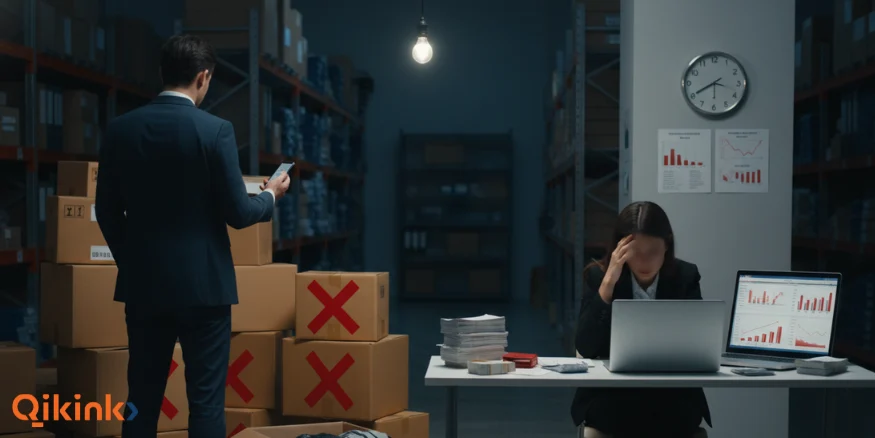
While Cash on Delivery increases orders and builds customer trust, it also brings several challenges and incurs hidden costs that directly impact profitability, operations, and cash flow. Below are the most common cash on delivery problems that every eCommerce business should manage carefully to continue their increasing profit.
1. Return to Origin (RTO) Rates
RTO rates are one of the biggest concerns in cash on delivery operations. According to recent eCommerce reports, around 26% of the cash on delivery orders are returned due to various reasons. These kinds of RTO occur in cash on delivery orders because:
- Customers might change their minds at the last minute of delivery.
- Insufficient cash at the time of delivery or a related situation.
- Unavailability of the customer or improper details leads to failure in dispatch.
Every return to origin means the seller pays for both forward and reverse shipping, which doubles their logistics costs. A high RTO rate immediately reduces profits and decreases the capital for future orders.
2. Invalid Orders
Because of the no-risk of paying upfront, some people tend to test multiple orders, choosing the best one and cancelling the remaining orders. Additionally, online sellers face various kinds of fake or fraudulent orders, like,
- Prank orders by competitors or even by normal people.
- On rare occasions, buyers wantedly provide wrong numbers to cancel the order at the last moment.
- A few people unknowingly or casually order a product because of the COD option and later cancel it.
This not only wastes packaging and labour, but also adds shipping expenses for sellers. For small and medium-sized stores, repeated fake orders can impact their investment and operational efficiency.
3. Delayed Payments
Unlike prepaid transactions, COD payments are not received instantly by the seller. It has a cycle of events, starting from a customer to the courier partner and then finally reaching the seller. The cash collected by courier partners is usually settled only after a delay of 3 to 7 days. This delay can cause:
- Difficulty for the seller to re-invest in their inventory, marketing or any production-related investments.
- A continuously delayed flow of cash can block their business temporarily.
- Depending on the courier partners to return the cash safely.
These delays make it harder to maintain a healthy business compared to prepaid or digital payments.
4. Shipping and Operational Cost
As previously said, cash on delivery can bring some unannounced and hidden expenses, such as,
- Courier partners would charge additional handling charges.
- Need to invest in tools or software for the verification of customer details.
- Extra packaging costs might be added during repeated delivery attempts.
Failing to monitor these factors can incur additional costs in COD orders and produce low profit margins.
5. Rejection at Delivery
This is a common issue at COD orders, where the customer rejects the order at their doorstep for many reasons. Some common scenarios could be:
- They found the same product somewhere else for a lower price.
- They changed their interest in their product choice.
- The delivery took more time than they expected.
And there are plenty of situations that allow the customer to cancel the order anytime because of it being a cash on delivery mode.
6. Address and Delivery Issues
This is an issue similar to incorrect details or phone number, and this is the most common issue with the cash on delivery payment mode. A wrong address may lead to delivery delays at the beginning, but it will be changed to the RTO stage in no time. This happens because,
- Missing landmarks or proper pin codes in the address already provided.
- Unclear door numbers or street names, especially inside rural areas.
- Customers not picking up the courier partner’s call at the time of delivery.
Each failed attempt increases the delivery cost, the risk of returns and refunds, and damages a brand’s value through poor fulfilment experiences.
7. Violation of COD Polices
Some customers misuse the cash on delivery rules by:
- Demanding to open parcels even before making payment.
- Claiming that they never placed the order.
- After delivery, the original product is replaced with used or old items during returns.
Such actions create major financial losses for sellers. This also requires strict verification by online stores, such as confirmation calls and other measures.
COD problems are part of business, but understanding them is the first step to reducing them. The following are the right strategies and solutions that help to control the COD problems.
Discover different types of dropshipping ads for your business

How to Reduce Cash on Delivery Problems: Step-by-Step Guide
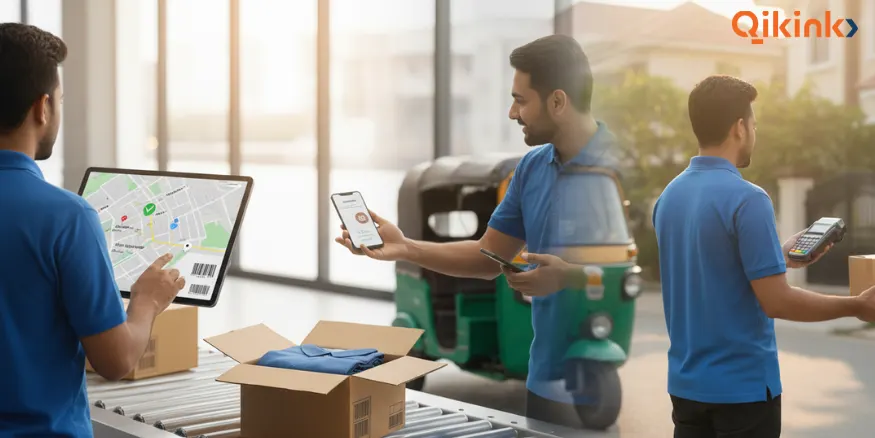
Step 1: Fix COD at Checkout
Many cash on delivery issues are created during checkout when customers order a product without the intent of buying. The seller has to rectify it from their side by,
- Set a minimum eligibility for orders, and an additional cost for ordering the product through COD.
- Promote more prepaid payments with priorities, to make the customer order it as a prepaid mode, instead of a COD.
- Highlight UPI or card payments, and choosing prepaid helps for faster and free of extra charges.
Step 2: Verify before Dispatch
A larger number of RTOs and returns occur due to incorrect addresses, numbers and sudden changes in the plans of customers. So, verifying every COD order at the initial stages will help reduce the returns rate.
- Use OTP verification for every COD order before checkout completion.
- Send a short confirmation message via WhatsApp, SMS, or even call directly to confirm the order.
- Set up automated cancellation for orders that are not confirmed within a 24-hour period.
Step 3: Provide a Clear Timeline
Late deliveries or unavoidable situations can cause problems. Providing real-time tracking of delivery can be helpful.
- Show accurate estimated delivery dates on the product page and at checkout.
- Share tracking link within 12 to 24 hours of dispatch and send notifications and updates via WhatsApp/SMS.
- Update customers on the day of delivery and highlight that it is a cash on delivery order, so they make sure to collect it with money.
Step 4: Validate Address
Incorrect address stands as the first reason for the increase in RTO rates.
- Implement PIN-code validation and auto-address suggestions during checkout.
- Ask for landmark details and an alternate phone number while they register their account for an order.
- Make COD unavailable for specific areas or unserviceable zones.
Step 5: Build Trust for Prepaid
Customers must trust that the seller’s page will handle prepaid orders.
- Show trust badges, reviews and secure payment icons near prepaid options.
- Include a page to show the terms and conditions and cash on delivery rules of the store.
- Remove the default selection for COD and let the customers navigate to another page for selecting COD.
Step 6: Coordinate with Delivery Partners
A professional courier delivery is what all the customers expect. So make sure to choose a perfect courier partner to give a better delivery experience to the customers.
- Ensure the delivery partner always calls the customers before the delivery time.
- If the buyer requires a reattempt to collect the delivery, the delivery partner must be prepared to help.
- Encourage the courier partner to accept payments using digital payments, too.
Step 7: NDR (Non-Delivery Report) Response
In Cash on Delivery shipping, the Non-Delivery Report or NDR plays a major role in notifying the customers from the courier side.
- On the failure of the first attempt, this offers customers a rescheduling of time or address for a reattempt of the order.
- Using WhatsApp, customers can get updates from customers like ‘Deliver tomorrow’ or ‘change address’.
- It automatically cancels unresponsive orders within 24 to 48 hours and can be customised to minimise unwanted returns.
Step 8: Limit COD for High-Risk Customers
Limit cash on delivery for customers who have cancelled a few COD orders before, and protect against the risk of unwanted order cancellations.
- Maintain a list of bad-order customers with repeated cancellations or no-delivery history and automatically restrict COD for 60 to 90 days.
- Restrict COD options for high-value personalised orders and for specific PIN codes.
- Try cash on delivery shopify integrations to automate risk control measures.
Step 9: Improve Packaging & Branding
First impressions always matter, and it starts with custom branding and packaging.
- Invest in neat, professional and eco-friendly packaging to get customers’ trust for repeated orders.
- Include a thank-you note and give a memorable unboxing experience to the buyers.
- Add a sticker saying that returns are accepted only after payment confirmation.
Step 10: Use Technology & Apps
Smart tools can automate verification, reduce fraud, and improve delivery success.
- Use apps that auto-verify numbers, run fraud checks, and validate orders before they enter fulfilment.
- Provide real-time tracking, NDR alerts, and faster status syncing to avoid communication delays.
- Automate cash tracking so sellers can easily match the amount collected by the courier with the correct order, avoiding any confusion or missing payments.
Step 11: Offer Instant Prepaid Conversion
Try to convert regular and COD-hesitant customers to prepaid by offering discounts or cashback.
- Lower the procedures for prepaid and offer quick deliveries in prepaid, and mention it on the checkout page.
- On successful deliveries, send follow-up messages encouraging prepaid next time.
- Provide UPI or payment links with offers and loyalty points for prepaid orders before they choose COD as a payment option.
Small, consistent changes across checkout, verification, courier coordination, and analytics will reduce RTO, protect margins, and keep COD as a controlled growth driver for the business.
Cash on Delivery Shopify and Dropshipping
Cash on delivery remains essential for dropshipping and Shopify-based stores in India, helping sellers reach customers who prefer cash on delivery payment. Implementing and managing COD effectively on Shopify can reduce the RTO rate, avoid losses, and increase customer trust.
How to Enable Cash on Delivery in Shopify?

Let’s break down a simple step-by-step structure for enabling COD in Shopify:
- Log in to the Shopify admin dashboard.
- Go to Settings and navigate to the Payments page.
- Scroll down to Manual Payment Methods and click Add manual payment method.
- Select Cash on Delivery (COD) from the dropdown.
- Add any necessary instructions and click Activate.
The customers will now see “Cash on Delivery” as a payment option at checkout. Standard Shopify settings don’t support detailed COD restrictions. For advanced controls like order value limits or PIN code restrictions, install specialised Shopify cash on delivery apps.
These apps analyse COD, based on geography or cart value, add fees, and convert COD orders to prepaid. Using them in Shopify or a dropshipping store adds an essential layer of fraud protection and operational efficiency.
Shopify Cash on Delivery Apps
While Shopify allows only basic COD setup, with the help of specialised apps, sellers can significantly improve how they manage COD orders, reduce cancellations, and increase prepaid conversions.
Some apps focus on automated cash on delivery order verification and notifications through SMS, WhatsApp, or OTP codes and help to confirm customer intent before the order proceeds. Some apps to mention:
- Releasit COD Fee & OTP Verify – Helps to automate OTP verification and manage COD fees before complete checkout.
- COD King‑COD Fees & OTP Verify – Provides secure OTP verification and customisable COD charges to reduce fake orders.
- Kwik COD & Checkout – Simplifies COD order processing with instant buyer verification and seamless checkout experience
- EasySell COD Form & Upsells – Enables quick COD order placement with customizable order forms.
And a lot more apps that are available for cash on delivery by Shopify. In addition to the notification apps, there are a few apps that help sellers convert COD orders to prepaid orders. For example,
- Shiprocket’s Prepaid Conversion Feature – Shiprocket helps sellers to send secure prepaid payment links post-order confirmation.
- Madgic Order COD Upsell – Allows for offering discounts and quick payment options to customers at COD checkout.
Using these India-based Shopify cash on delivery apps, sellers can optimise payment reliability, reduce fraud risks, and grow prepaid adoption, especially suited to Indian buyer behaviour and delivery ecosystems.
Cash on Delivery Dropshipping
COD dropshipping is a widely preferred eCommerce business in India, but it also comes with higher RTO risks. Since dropshippers don’t stock inventory, every return becomes a considerable loss. To run cash on delivery dropshipping successfully:
- Always verify every COD order and enable the fulfilment only after verification to avoid duplicate or fake orders.
- Coordinate with the best dropshipping suppliers and courier partners to handle COD payment collections effectively, ensuring smooth delivery.
- Work with the best regional fulfilment partners like Qikink. With Qikink, sellers don’t need to worry about additional charges, because they provide them with no RTO charges.
For new brands, prepaid orders give better profit margins, but COD brings more first-time buyers. Start with an approach that includes both COD and prepaid models, and offer fast prepaid delivery to be the customer’s favourite brand.
Why Qikink Makes COD Easier?

Managing COD orders effectively is a challenge for many online sellers, but Qikink simplifies the process, making it a hassle-free and scalable payment option for your eCommerce or Print on Demand (POD) store. Here’s how Qikink helps you handle COD smoothly:
- With no RTO charges, best branding and packaging solutions, Qikink provides you with the best regional fulfilment services in India and stands out as the best in the business.
- Seamless integration with eCommerce stores like Shopify and WooCommerce, allowing you to customise and sell products on broader platforms.
- Offers its sellers a wide range of product categories to design and customise their favourite products for selling.
- Choose to receive your COD payments either as credits in your Qikink wallet or as a direct bank transfer after verifying your bank details.
- Provides transparent order tracking, inventory management, and support to help sellers manage COD processes effectively.
With Qikink, cash on delivery is no longer a risky or complicated payment method but a reliable choice that helps expand sellers’ customer base while minimising operations. Because of Qikink, scaling your eCommerce or dropshipping business in India is far easier.
How to Start Print on Demand with Shopify: A Step by Step Guide

Final Thoughts
Cash on Delivery remains one of the strongest conversion drivers for first-time buyers in this eCommerce industry. The goal is not to remove COD, but to manage it with the perfect tools and courier coordination so that it becomes the primary reason for success.
By applying smart verification, improving delivery communication, strengthening prepaid trust, and leveraging technology, brands can turn COD from a costly risk into a controlled, profitable channel.
Whether you run a Shopify store, a dropshipping business, or a full-scale D2C brand, the most successful approach is to offer COD to acquire new customers and use strategic moves to shift repeat buyers to prepaid later for higher profit.
Choosing the right fulfilment partner like Qikink, COD becomes even easier to manage. Join today and sign up with Qikink and scale your business only in the way of growth.
Read More
Frequently Asked Questions
Is cash on delivery profitable?
Yes, Cash on Delivery can be profitable if managed well. While COD has higher operational costs, returns, and delayed payments, these can be balanced with strategic verification, reliable courier partners, and technology. For many Indian businesses, COD remains a vital trust-building and customer acquisition tool, contributing significantly to sales growth.
How do I enable cash on delivery options?
Enabling COD depends on your eCommerce platform and courier partner. For example, on Shopify, you can allow COD by adding a Cash on Delivery payment method from your Payment Settings or using trusted Shopify COD apps for verification and fee setup. Choose courier partners who support COD remittance and digital reconciliation to manage cash flow smoothly.
Which is best, cash on delivery or online payment?
COD increases trust and order volume, especially for new or hesitant buyers, but comes with higher Return to Origin rates and delayed settlements. Prepaid payments provide instant cash flow, lower returns, and better profit margins, but may limit reach to less tech-reliable customers.
How to reduce COD returns?
To reduce COD returns (RTO), focus on verification, communication, and customer readiness. Top strategies include:
- OTP and WhatsApp confirmation before dispatch
- Clear delivery timeline updates
- Address validation & alternate contact collection
- NDR follow-ups within 24–48 hours
- Small incentives to convert COD to prepaid
What strategies can eCommerce businesses use to minimise instances of fraudulent COD orders?
To reduce instances of fraudulent COD orders, eCommerce businesses can implement measures such as verifying customer details, using fraud detection tools, and limiting COD orders for first-time customers.

